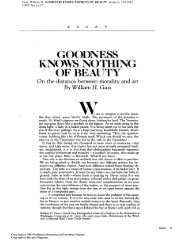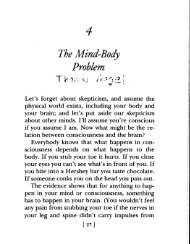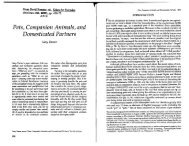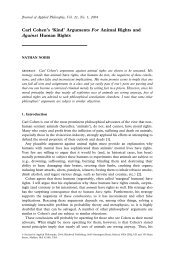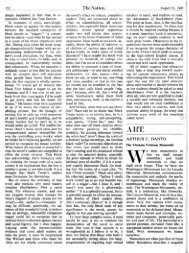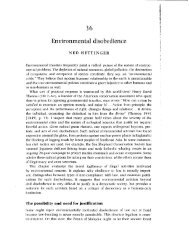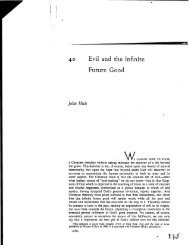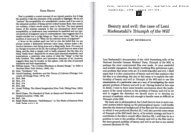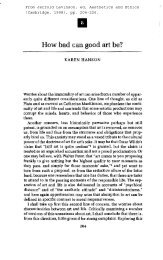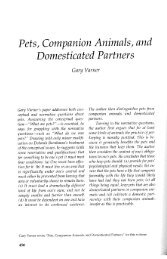Bruce Baugh, "Prolegomena to Any Aesthetics of Rock Music"
Bruce Baugh, "Prolegomena to Any Aesthetics of Rock Music"
Bruce Baugh, "Prolegomena to Any Aesthetics of Rock Music"
You also want an ePaper? Increase the reach of your titles
YUMPU automatically turns print PDFs into web optimized ePapers that Google loves.
<strong>Baugh</strong> <strong>Prolegomena</strong> <strong>to</strong> <strong>Any</strong> <strong>Aesthetics</strong> <strong>of</strong> <strong>Rock</strong> Music25cause <strong>of</strong> conditioned, subjective sensations andpleasures, which could form the basis only <strong>of</strong>impure and heteronomous aesthetic judgments.This, though, was only a first step in Hanslick'sproject <strong>of</strong> elevating music from the position <strong>of</strong>lowest <strong>of</strong> the fine arts <strong>to</strong> the highest and mostformal art <strong>of</strong> all. "Music is unique among thearts," wrote Hanslick, "because its form is itscontent and ... its content is its form" (Hanslick,p. 94). In music, unlike painting or literature,there can be no content apart from the formitself, no subject matter independent <strong>of</strong> the compositionor organization <strong>of</strong> the work. Musicalbeauty, then, is entirely based on form, that is,on <strong>to</strong>nal relationships (Hanslick, p. xxiii), andnot on any feelings or emotions aroused or expressedby the music (Hanslick, p. 95). By makingthe matter <strong>of</strong> music (musical <strong>to</strong>nes) formal,and by making form identical with content, Hanslickmade the art Kant regarded as the basest andmost material in<strong>to</strong> the highest and most formal.Of course, the s<strong>to</strong>ry doesn't s<strong>to</strong>p with Hanslick.The preoccupation with musical form continueson in<strong>to</strong> twentieth century aesthetics, notablyin Adorno's philosophy <strong>of</strong> music, but in amore everyday way, formal concerns predominatein music criticism in general, from journalism<strong>to</strong> academia.4The obvious rejoinder <strong>to</strong> this characterization<strong>of</strong> traditional aesthetics is that it is not exclusivelyformal, but takes in<strong>to</strong> account non-formalor material elements as well. The timbre <strong>of</strong> avoice or instrument is clearly <strong>of</strong> great importance<strong>to</strong> European concert music; if they weren't,<strong>to</strong>p caliber bel can<strong>to</strong> sopranos and Stradivariusviolins wouldn't command so much respect andsuch high prices. Music criticism also takes performanceaspects <strong>of</strong> music in<strong>to</strong> account. Buttimbre and performance are usually secondary,and are <strong>of</strong>ten discussed in terms <strong>of</strong> the "faithfulness"or "adequacy" <strong>of</strong> the performance/interpretation<strong>to</strong> the composition performed or <strong>to</strong>the composer's "intentions." One justificationfor playing music on period instruments and inperiod style is that this better captures what thecomposition was trying <strong>to</strong> express, not simplythat it sounds better or is more pleasant <strong>to</strong> listen<strong>to</strong>. In that case, performance and the notes'sounds are judged in terms <strong>of</strong> what the compositionrequires. In classical aesthetics <strong>of</strong> music,matter is at the service <strong>of</strong> form, and is alwaysjudged in relation <strong>to</strong> form. Even though tradi-tional aesthetics is not exclusively formal, formalconsiderations predominate.When this preoccupation with form and compositionis brought <strong>to</strong> bear on rock music, thechief result is confusion. Usually, rock music isdismissed as insignificant on account <strong>of</strong> the simplicity<strong>of</strong> its forms, a simplicity which is real,and not a misperception by those unfamiliar withthe genre. Alternatively, more "liberal" criticswill try <strong>to</strong> find significant form where there isvery little form at all, and at the expense <strong>of</strong>neglecting what is really at stake in rock music.This liberal <strong>to</strong>lerance is a worse mistake thanconservative in<strong>to</strong>lerance. In the first place, itis highly condescending <strong>to</strong> suppose that rockmusic has value only when it approximates thecompositional forms <strong>of</strong> baroque or romantic music.The Beatles, in particular, were victims <strong>of</strong>this patronizing attitude. Is "Penny Lane" abetter rock song than "Strawberry Fields" becausethe former contains flourishes <strong>of</strong> Baroquetrumpet and the latter doesn't?5 Does knowingthat "She's Leaving Home" ends on an Aeoliancadence add <strong>to</strong> our appreciation <strong>of</strong> it as a rocksong?6 I don't think so. Yet for a time, in the late1960s and early 1970s, critics fawned over complicatedworks by Yes or Genesis because traditionalaesthetics <strong>of</strong> music could find something<strong>to</strong> say about their form, never noticing that crite-ria appropriate <strong>to</strong> the music <strong>of</strong> Handel or Boulezmight be inappropriate when applied <strong>to</strong> rockmusic, and have very little <strong>to</strong> do with the informalstandards <strong>of</strong> practice and evaluation employedby people who actually perform or listen<strong>to</strong> rock music on a regular basis.To the extent that some rock musicians <strong>to</strong>okthis sort <strong>of</strong> criticism seriously, the results weredisastrous, producing the embarrassing, pretentiousand-in the final analysis-very silly excesses<strong>of</strong> "art rock." To the extent art rocksucceeded, it did so because it was rock, notbecause it was "art." This was especially noticeablein the case <strong>of</strong> the mercifully short-lived sub-genre, the "rock opera." The Who's Tommy7 wasa good rock opera because it had good rockmusic and was done <strong>to</strong>ngue-in-cheek (hence its"Underture"), but other attempts were merelybombastic, neither rock nor opera. <strong>Rock</strong>'s borrowingsfrom "classical" music had similar results.Combining a soulful rhythm and bluesvocal with a Baroque organ line worked in ProculHarem's "Whiter Shade <strong>of</strong> Pale,"8 but in



